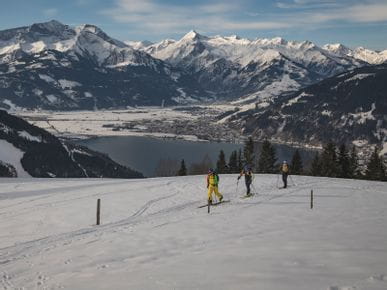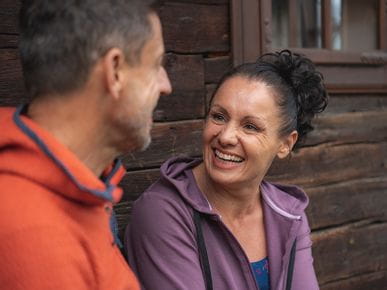On the Power of the Forest
Christoph Bründl spoke with Theresa Sommerbichler, an aspiring forest and health coach, about the topic of forest bathing.
In the following interview, you'll learn how the forest helps us leave our stresses of daily life behind and find our inner balance.
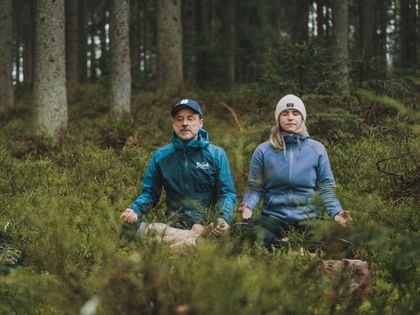
Christoph: Forest bathing comes from Japan, where it's called "Shinrin Yoku", and its healing effects and ability to reduce stress have been scientifically researched and used in therapies since the 1980s. Here, people often chuckle when they hear the term "forest bathing". But it’s supposed to strengthen the immune system and can even help against cancer, right?
Theresa: First, we need to define the term "forest bathing". It means consciously immersing yourself in the atmosphere of the forest and perceiving the nature around us. However, it's also important to emphasize that each person needs to define forest bathing for themselves and find the mindfulness, meditation, and breathing exercises in the forest that best work for them personally. It's a relaxation method that has a positive impact on the parasympathetic nervous system, which in turn stimulates the natural production of T-cells, also known as killer cells, and thereby strengthens the immune system. Moreover, forest bathing supports stress reduction, mental balance, and improves the musculoskeletal system through moderate walking.
Christoph: Speaking of mindfulness - we all know by now how important it is for us and those around us to live mindfully and with all our senses, consciously aware of our lives and actions. Gratitude is also a part of that. How can a visit to the forest help me with this - what do those "green giants" have to teach me?
Theresa: So, when I talk about mindfulness, I think it's important to first define what is meant by the term. Mindfulness means being consciously present in the moment, actively perceiving your surroundings, and not making quick judgments. We can learn a lot from nature and the living beings within it, such as not always judging or condemning. When I look at nature, I see different species living in harmony and supporting each other. Take trees, for example, and the mycorrhizal networks of fungi. They live in symbiosis and exchange nutrients without endangering their own species. We can definitely learn from nature about how to be mindful in our interactions with one another, as well as with ourselves, and not to judge.
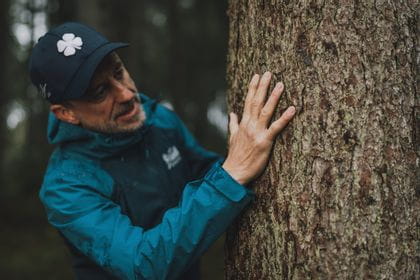
Christoph: Exercise in nature became increasingly popular during the pandemic – now that everyday life has largely returned to normal, old habits are creeping back in. However, you don't need vast expanses of nature for forest bathing – even the city park around the corner can be an energy-rich oasis for strength and healing – what would your perfect "green" office lunch break look like?
Theresa: When I need a break, I turn off my phone and switch to "forest mode." I go for a little walk, focusing on my breathing to leave stress behind. Then, I find a spot somewhere green, preferably under a tree, and enjoy my lunch break. I eat something, maybe read a bit, and then continue my stroll. I consciously pay attention to my breathing, as movement and breathing are the essence of life itself. Even if I'm just in the city park, nature most definitely helps me relax and recharge my batteries.
Christoph: Overuse of the media, lack of exercise, the stresses of school and even of recreation – children today face many demands and might well struggle to find the peace and relaxation they really need. There are studies out there showing that children with ADHD were noticeably more relaxed and focused after spending time in green spaces. How can we introduce children to forest bathing and get them excited about the forest?
Theresa: Playfully, most definitely, or at least age-appropriately for teenagers. Before Christmas, I was at a kindergarten in Pfarrwerfen, where I playfully introduced the children to forest bathing. I incorporated simple movement exercises, sang forest songs, we made bird feeders, and decorated a tree in the forest. With teenagers, it's often not that easy, so I try to bring them a bit closer to the forest world and its natural products by making things like a hair conditioner made from spruce needles or a lip balm.

Christoph: Theresa, you describe yourself as a creative mind, an enthusiastic explorer, and a inquisitive nature lover. What inspired you to hang up your secure job to devote yourself to the healing powers and secrets of Mother Nature?
Theresa: My journey began in 2014 when a stroke of fate impacted my family. I was overwhelmed and didn't know how to cope. A coworker advised me to go to the mountains, which I did. So, early one morning, I hiked up to the Bockhartscharte in Rauris and sat myself down there. Suddenly, I had a completely new perspective on everything. Hiking in nature helped me find myself again, and it made me feel better. Nature then gradually became my hobby. Two years ago, I was sitting in the office, and I realized that I couldn't truly connect with the people I wanted to reach. What I really wanted to do was to help people and show them what had helped me. And then I had the idea: Why not do what I'm best at and what I love most? Inspiring people, talking about nature, hiking, making them aware about nature as a form of relaxation. Currently, in addition to my independent activities, I'm also working with the University of Salzburg and the University of Munich on the WIWA² project. In this project, we analyze natural spaces and try to find out in which forms forest and water have the positive effects on the human organism.
Christoph: Thanks to digital connectivity, we can now connect with other people at the push of a button, anytime and anywhere. Ironically, this often makes us feel quite lonely. In the world of work, digitization leads to an "always on" mentality. Employees are often available around the clock, unable to separate work hours from leisure time. In Japan, forest bathing is already recognized as a form of therapy and prescribed by doctors. Rehabilitation centers are also being built at the edge of forests. Is this model or form of therapy conceivable for Austria in the future?
Theresa: Why not? The system definitely needs to change, but for example, there is already a therapy center in Lower Austria where forest bathing is integrated into therapy. I personally have a modest dream of mine, of a forest center, located in the middle of a spruce or deciduous forest, which should be an oasis for peace and relaxation.
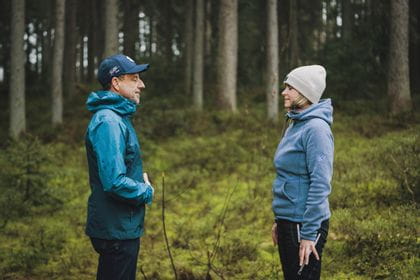
Christoph: Let us talk for a moment about the tremendous energy that exists in the forest: Trees are interconnected underground and communicate through what some folks refer to as the "Wood Wide Web." This sounds fascinating, what exactly is going on there?
Theresa: Trees are connected underground through a mycorrhizal fungal network, allowing them to exchange nutrients with each other and also with fungi. The fungi involved have a fine root system that infests the root of the tree and actually lives in symbiosis with it. The fungi receive sugar from the tree, and in return, the tree's absorption of nutrients and water is facilitated.
Christoph: Trees release various messenger substances through their bark, such as the terpenes we find in coniferous trees – what do these consist of, what is their benefit for nature, and how can they give us a health boost?
Theresa: Terpenes in coniferous trees and isoprenes in deciduous trees are messenger substances by means of which trees can also communicate. These produce the typical forest smell, which is especially intense after rain. These messenger substances are usually released in great quantities in order, for example, to warn fellow species about voracious insects. They have a positive effect on our nervous system and help us to find peace.
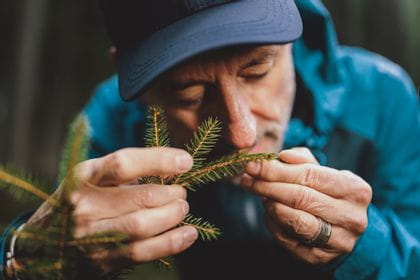
Christoph: Speaking of creativity - forest bathing is also said to stimulate creative processes and contribute to increased concentration. How does that work?
Theresa: When we are in "forest mode", which allows us to relax and disconnect, we manage to restart the creative process. Just like in the saying, "sleep on it for a night", often a short break is all it takes to reveal different perspectives and completely new paths forward.
Christoph: Our readers are probably wondering: How often and for how long should you practice forest bathing before the desired effect sets in? And what tips can you give us to benefit from the healing powers of the forest for as long as possible?
Theresa: Unfortunately, there are currently no studies on how often and for how long one should practice forest bathing. However, there are studies showing that spending several hours regularly in the forest leads to more relaxation and thus makes the parasympathetic nervous system very active. The parasympathetic system is our "resting nerve", if you will, responsible for relaxation and regeneration. My personal opinion: Incorporate the forest into your daily life! For example, go out into nature during your lunch break, even if it's just a city park next to your office!
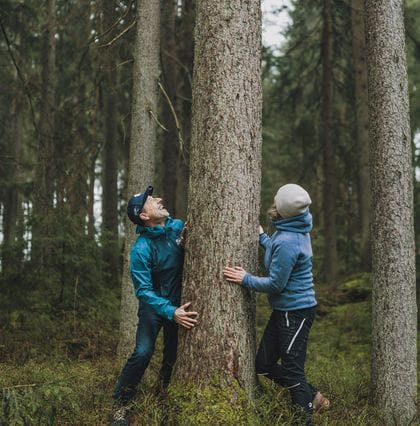
Christoph: We want to show our readers that forest bathing benefits everyone, is easy to learn, and requires no equipment. We are standing here in the middle of the forest; what does a typical forest bathing session go like for you?
Theresa: In the summer, a typical forest bathing session for me lasts about 4 hours and goes like this:
1. Smiling face: We share a story from the forest that we each remember.
2. Worry backpack: We hang our worries on the forest coat rack.
3. Sensory scan: We open our senses. Under my guidance, we focus step by step on our sense of touch, hearing, smell, and sight.
4. Feeling game: We take off our shoes and explore the forest floor barefoot. After that, we take turns guiding each other to a tree with closed eyes. The "blind" person is allowed to touch and feel it. After being guided "blind", the same subject now has to find their tree again. This is an exercise I also enjoy doing with kids.
5. Sending and receiving: Trees give us oxygen. We give them carbon dioxide, which they need for photosynthesis. Each person chooses a tree and imagines that this tree gives them oxygen, and we give it all the carbon dioxide it needs. Sending and receiving, in other words.
6. Drinking forest oxymel and gratitude: We sit together on the forest floor and drink a glass of homemade forest oxymel. I tell my story and ask everyone to consider what they are truly profoundly grateful for within themselves. Usually, there are a few moments of silence, which is definitely a good sign.
7. Walking back together: In silence or not, whatever suits each person best.
Christoph: What tips would you like to share with our customers for an active, energizing summer?
Theresa: Stay true to yourself, get to know yourself, find your passion. Only when I am true to myself and know what I want, can I be there for others.
Christoph: Thank you, Theresa, for this moving and inspiring conversation!

